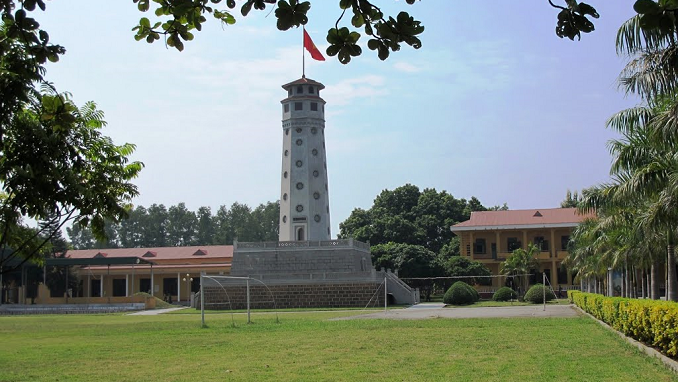The flagpole, also known as the flag tower, was built in the center of Hung Hoa citadel, Tam Nong district, Phu Tho province. Hung Hoa flagpole is one of the four largest and oldest flagpoles of Vietnam, a symbol of the tradition of fighting against foreign invaders, a cultural work imbued with patriotism and sacrifice for the great cause of famous people. Culture of Nguyen Quang Bich and patriotic scholars.
Hung Hoa citadel was the capital of Thua Tuyen Hung religion, then Hung Hoa town. The citadel defended by Nguyen Quang Bich has an important strategic position, from here it is possible to go backwards and forwards, deploying combat forces very conveniently. In the citadel, there is a flagpole (also known as a flag tower), built in the 3rd year of Thieu Tri (1842). The flagpole of Hung Hoa citadel is a sacred symbol of the people of Hung province and has become a symbol of the spirit of Nguyen Quang Bich and the Can Vuong insurgents in the Northwest.
Over time and the ravages of wars, this structure was almost completely destroyed. After the day of peace was restored (1954), the remnants of Hung Hoa ancient citadel we only know of the sincere traces left running along Tan Hung Street and the pedestal of the flagpole located in the military barracks area (Lu group 543) in the center of Hung Hoa town. The silhouette of the ancient citadel, the flagpole and the Temple of Literature in Hung province have all gone into the past. All of them were destroyed in the early years… the war against the French (1947). In 2009, with the efforts of the Party Committee and people of Phu Tho province in general and Tam Nong district in particular; The flagpole of Hung Hoa citadel was restored on the old foundation.
Overall, the flagpole consists of 3 floors, has an octagonal shape, the total height from the base to the top of the flagpole is 23.84m:
- The first floor is also known as the large base, square shape, each side is 17.52m long and 2.4m high.
- The second floor, also known as the small base, is also square, with each side 11.4m long and 3.1m high.
- The 3rd floor is also known as the flagpole, tapering octagonal shape, 18.34m high, inside there are 55 steps to build a spiral to the top; with gazebo windows; the top has a round pillar (flag holder).
The flagpole of Hung Hoa citadel has been associated with the cause of Can Vuong of Nguyen Quang Bich (someone called the uprising Nguyen Quang Bich), a patriotic scholar who raised the Can Vuong flag against the invasion of the French colonialists in the past years. late nineteenth century.
Hung Hoa flagpole is the place that marked the glorious events of him and patriotic scholars. Today, although it is no longer intact as in the past, the flagpole monument of Hung Hoa citadel with its lofty, great and sustainable human values, the good tradition of the nation has been preserved and passed on to the people. generations. The relic is forever the great pride of the people in the mountainous areas of the Northwest and of the entire Vietnamese nation.
Preserving and embellishing the monument of the flagpole of Hung Hoa citadel so that generations of Vietnamese people today and in the future will always be proud of his revolutionary tradition, unyielding will, indomitable struggle to build and defend the country. father, is a place for descendants to gather forever, respectfully remembering the great merits of their predecessors, a typical example forever shining for generations on the path of building and protecting Vietnamese Fatherland.
Source: Collected internet.
